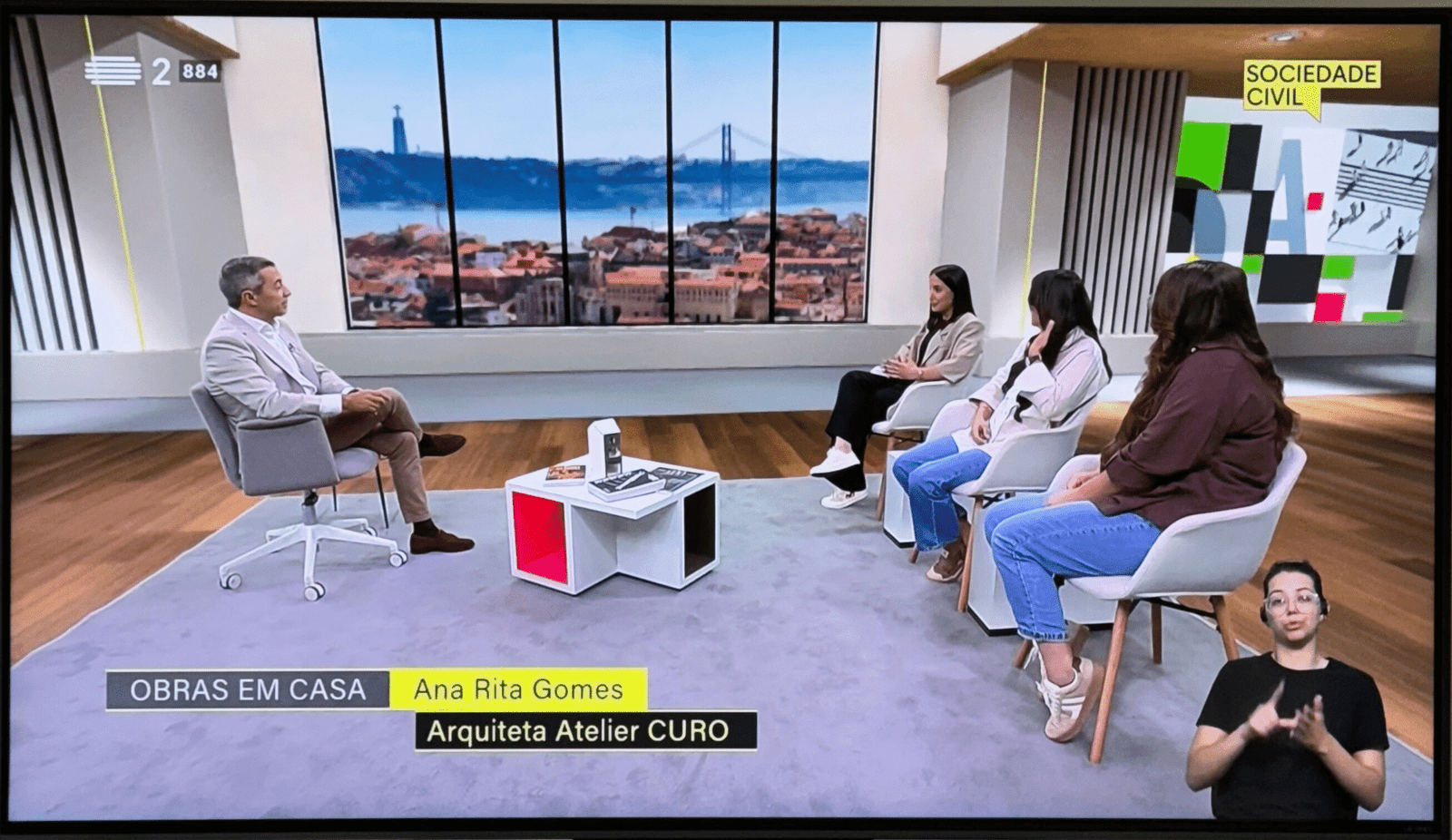For many, renovating a home is the beginning of a dream. However, the process isn’t always simple: between deadlines, budgets, and decisions, what should be an exciting experience can quickly turn into a challenge. It was precisely on this topic that the program Sociedade Civil, hosted by Luís Castro at RTP2, dedicated one of its most recent episodes to the topic, bringing together professionals with different perspectives from the industry: Ana Rita Gomes, architect and CEO of CURO, Bárbara Morais, digital content creator, and Joana Laranjeirafounder of Atelier do Ó.
Backgrounds and Early Projects
The conversation began with each guest’s background in the world of architecture and renovation.
Ana Rita Gomes, who leads the studio CURO, in Águeda, shared that her first major project came from within her own family: “I started with my brother’s house, a new build from the ground up. He believed in me, and that’s how CURO was born.
The studio, now with four years of activity, stands out for its approach that combines technical precision with a strong emotional component and close client support.
On the other hand, Joana Laranjeira explained that her path is closely aligned with digital communication. She founded Atelier do Ó, but she continues to use social media as an extension of her work, sharing decorating tips and small home improvements that anyone can try themselves. “Online, I’m speaking to a camera — it’s not the same as working on a real project with an architect. On social media, the advice tends to be more general,” she noted.
And Bárbara Morais is an influencer and digital content creator. On the @familiabeijaflor social media accounts, she shares the renovation of a 1930s house in Vila do Conde.
The Soul of a Home
Mais do que falar de obras em casa, o programa abordou o que realmente dá a home its personality..
For Ana Rita Gomes“what makes a house is what turns it into a home.” Whether it’s a new build or a restoration, the architect believes the secret lies in understanding the people who will live there.“For instance, if they come from different nationalities, there’s always a mediation process; or when it’s a former grandmother’s house, it’s important to preserve certain features that keep the memory alive.”
With the thoughtful perspective that defines CURO’s work, Ana Rita also emphasised that“an extremely tidy house is an uninhabited one. If that were the case, we’d all live in hotel rooms.”.
Bárbara Moraiscreator of the @familiabeijaflor, added that a space should reflect those who live in it:A woman turns a house into a home. For me to live in a house, it has to be adapted to me — it has to carry my personality. It can’t be a copy-paste of other homes.”
The three guests reached a clear consensus: a home gains a soul when it’s designed around people — not trends.
Profiles and Differences Among Clients
The conversation moved on to the differences in client profiles, a topic the architects know well.
In general, women tend to be more attentive to aesthetics, comfort, and functionality, valuing details such as pantries, laundry rooms, and storage spaces. Men, on the other hand, are often more focused on the technical aspects of construction.
Understanding these differences, they argue, is essential to tailoring each project to the real needs of every family.

Industry Challenges
When the conversation turned to the challenges of renovation work em casa, surgiram pontos de vista complementares.
For Bárbara Moraisthe main obstacle remains the lack of qualified labor and contractors’ failure to meet deadlines.
Joana Laranjeira highlighted another issue: many clients still have a limited perception of the value of architectural design. “Some people request three quotes and choose solely based on price — only to realize later that the result isn’t what they expected,” she noted.
On the other hand, Ana Rita Gomes emphasised the importance of the planning stage and the architect’s role as the project’s manager.Major problems don’t start during construction — they start before it,, she explained. “An architect doesn’t just design; they’re responsible for ensuring that the project complies with regulations, deadlines, and legal requirements.”
The architect also stressed that risks increase when renovation work doesn’t follow the proper standards: “The problem isn’t that people want to give their homes a new life, but when things don’t meet the necessary requirements — and once they’re done, City Hall won’t approve them.”
The Practical Side: Contractors and Deadlines
The program also featured the participation of João Correia, a construction entrepreneur who joined the discussion via video call. He explained that his company specialises in renovations and that its goal is “to take ideas off the page and turn the client’s dream into reality.”
He acknowledged, however, that the shortage of qualified labor , is one of the biggest challenges in the industry. According to João, it’s common for companies to manage several projects at the same time, reallocating teams from one site to another — which often leads to delays. “We chose a different approach: we prefer to finish one project before starting the next,” he said.
The discussion also touched on issues such as unfair competition, including cases of contractors who work without insurance or abandon projects after receiving a deposit, leaving clients without a solution.
Construir com confiança e (c)alma
At the end of the conversation, the guests shared messages that summed up their vision of the industry.
For Bárbara Morais, it’s essential to value construction professionals, reminding that “a renovation takes time, and the investment is worth it."
Joana Laranjeira emphasised the need to to pay a fair price for good work, stating that “you can’t choose based on price alone and expect the same result.
On the other hand, Ana Rita Gomes she concluded with a message of optimism: Building doesn’t have to be something we’re afraid of. A project should be built on four pillars: safety, comfort, functionality, and aesthetics.”
Watch the full episode
The episode Obras em Casa of Sociedade Civil is available on the website of RTP2.
About CURO
The CURO is an architecture studio based in Águeda, founded by Ana Rita Gomes, with a focus on residential projects and renovation. The studio believes that every home should reflect the identity and memories of those who live in it, bringing together functionality, comfort, and aesthetics in a process marked by close and human-centered guidance. Want to renovate or build? Get in touch.

